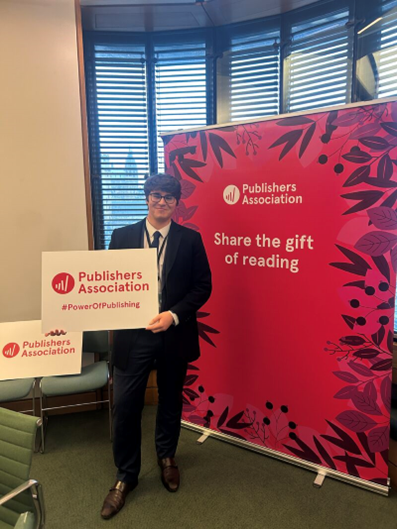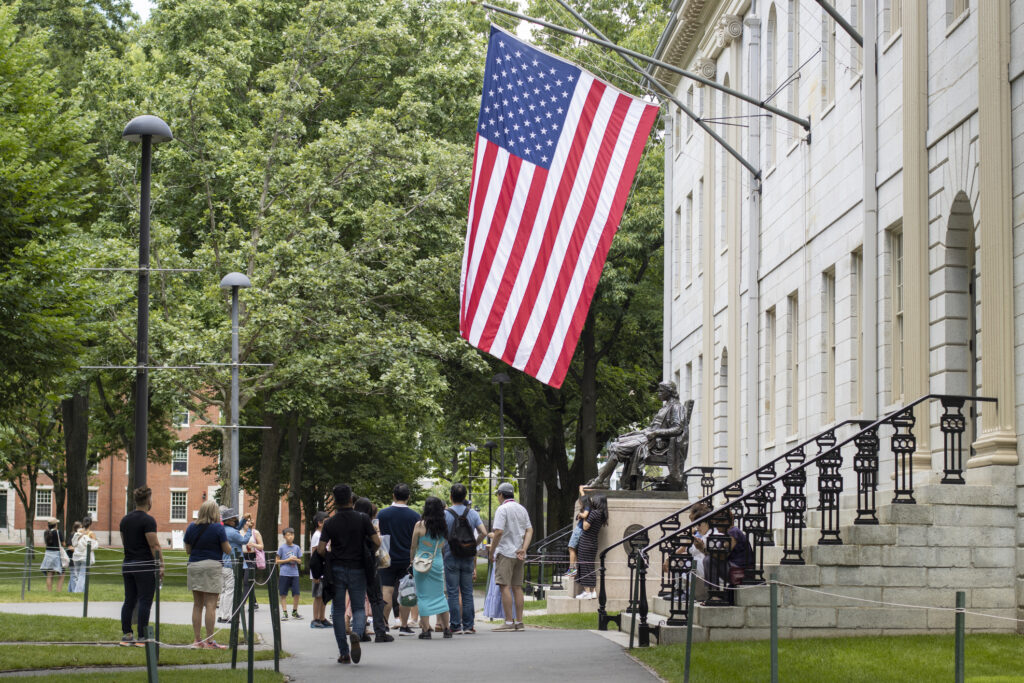- Gill Evans is Emeritus Professor of Medieval Theology and Intellectual History at the University of Cambridge.
In early March 2025, the Trump administration sent letters to 60 US universities warning them that they faced ‘potential enforcement actions’ for what it described as ‘failure to protect Jewish students on campus’ during the widespread pro-Palestinian protests on campuses during the last year. This Government direction not only permitted terms to be set on which continuing funding was to be conditional for a specific higher education provider, but also allowed those terms to encroach on the academic freedom of an institution to choose what to teach and how. This ‘Project 2025’ also allowed the President to require a significant proportion of funding to go to the provision of ‘business’ courses.
There were wider consequences of these Government directions. The resulting limitation of funding for research quickly prompted hints of restricted publication of results and encouraged US academics to seek employment in Canada, the UK and Europe.
Though it was joined in its active resistance by Yale and Princeton, Harvard became a test case. It objected to the Government demand that it immediately agree:
to implement the Trump administration’s demands to overhaul the University’s governance and leadership, academic programs, admissions system, hiring process, and discipline system—with the promise of more demands to come
and thus ‘overtly seek to impose on Harvard University political views and policy preferences advanced by the Trump administration and commit the University to punishing disfavored speech’. [1] The US Education Department speedily responded, announcing on 14 April that it was freezing about $2.3bn of Harvard’s funding. On 15 April, Trump threatened to remove Harvard’s tax-exempt status,
US universities are divided into the ‘private’ and ‘public’ on the basis of their funding and therefore differ in the extent to which they are at risk of loss of funding in attacks on their academic freedom. The ‘private’ Ivy League universities enjoy substantial endowments, making them less dependent on their supplementary Government funding than their ‘public’ counterparts.
The Office for Students funds and regulates higher education in England. MEDR, the Welsh Commission for Tertiary Education and Research, funds and regulates higher education in Wales, taking these responsibilities over from the former Higher Education Funding Council for Wales. The counterpart body for Scotland is the Scottish Funding Council. This depends on the Scottish Government for the funding it disburses to providers.
English higher education providers enjoy an institutional autonomy, strengthened by the fact that Government funding for English higher education was greatly reduced with the progressive ending of a ‘block grant’ under the Higher Education Act of 2004 and the raising of tuition fees in 2012. That was replaced by much higher student tuition fees under the Higher Education and Research Act of 2017.
Under the same legislation the autonomy of higher education providers in England is protected, with express reference to their right to design their own courses, choose their students and appoint their academic staff. This extends to higher education at tertiary education levels 4 and 5 as well as to ‘degree-level’ 6 and postgraduate degrees at levels 7 and 8.
This legislative permission does not allow a free-for-all. ‘University’ is a ‘sensitive term’ in English law, as are ‘higher’ and ‘accreditation’ when used of education. New providers may grant their own degrees and call themselves ‘universities’ only if they have powers to do so. In the case of new providers that requires Registration by the Office for Students (OfS). The OfS is subject only to ‘guidance on strategic priorities from the Department for Education’, though its activity is open to expressions of Parliamentary concern. For example, on 2 April 2025, the House of Commons debated ‘the impact of university finances on jobs in higher education’. It was suggested that ‘the funding model, which depends on international students paying higher fees, has harmed universities since Brexit’, but it was recognised that only public funding and such broad policy preferences lay with the Government.
The accreditation of qualifications in the UK is the responsibility of a number of agencies, some of which are professional and some are public bodies. In the USA ‘relying on private, independent accrediting agencies has been the most important tool for preventing the centralized political control of higher education in the United States’. The authority of the Trump directive over these seemed clear at first.
What protects the institutional autonomy of US Universities? The nearest US counterpart to the Office for Students is the Higher Learning Commission, an independent agency founded in 1895. It accredits institutions granting degrees. The University of Michigan, for example seeks renewal of its accreditation from the Higher Learning Commission every ten years. Its ‘evaluations’ are conducted by reviewers from other institutions not the HLC itself.
The award of ‘University title’ and degree-awarding powers is not restricted in the US as it is in England. For example they may derive from a Charter establishing the institution. Its own Charter granted the Trustees of Columbia University degree-awarding powers and powers to create such:
ordinances and by-laws which to them shall seem expedient for carrying into effect the designs of their institution; Provided always, That such ordinances or by-laws shall not make the religious tenets of any person a condition of admission to any privilege or office in the said college, nor be inconsistent with the constitution and laws of this state, nor with the constitution and laws of the United States.
Private US universities
The privately funded Ivy League Universities were set up with a degree of constitutional independence. Each had a State-based beginning. Harvard was established as a College by the General Court of Massachusetts Bay Colony in 1636 with funding of £400. Its stated purpose was to ensure that the Puritans should be provided with educated ministers, by advancing ‘learning’ to meet the needs of ‘posterity’ and to avoid leaving churches with ‘an illiterate ministry’. Princeton, founded in 1746 by the Presbyterian Synod as the College of New Jersey, had its name changed to Princeton University in 1896. Its present charter dates from 1748. It too has Trustees. In an age when it could be expected that those arriving from England would be practising members of the Church of England, it was insistent about religious freedom:
Petitioners have also expressed their earnest Desire that those of every Religious Denomination may have free and Equal Liberty and Advantage in the Said College any different Sentiments in Religion notwithstanding.
Columbia, too, began as a College. It was granted a Royal Charter in 1754, making its governors a ‘body corporate’. In 1912, the corporate name was changed to ‘Columbia University’. A series of amendments followed, with an Act of the people of the State of New York in 1810 clarifying the position. Its Trustees were to form ‘a body politic and corporate’ ‘in the City of New York’, with ‘continual succession for ever’ and a common seal. The powers of its Trustees as governors were set out in detail, separating them decisively from the ‘professors’ and ‘tutors ‘. The Trustees were to:
have full power and authority to direct and prescribe the course of study, and the discipline to be observed in the said college, and also to select by ballot or otherwise, a president of the said college, who shall hold his office during good behavior,
but no ‘professor, tutor, or other assistant officer’ was to be a Trustee. There was to be an executive body, consisting of eleven of the Trustees, constituting ‘a quorum for the despatch of all [routine] business’.
Its Statutes include a ‘Code of Academic Freedom and Tenure’:
Academic freedom implies that all officers of instruction are entitled to freedom in the classroom in discussing their subjects; that they are entitled to freedom in research and in the publication of its results; and that they may not be penalized by the University for expressions of opinion or associations in their private or civic capacity; but they should bear in mind the special obligations arising from their position in the academic community.
In March 2025, seeking to force the University of Columbia to comply with his instructions, the President of the USA withdrew $400m of federal funding. Nine specific ’reforms’ had been called for in this case, including a change of Departmental Head and modifications to its provision of Middle Eastern, South Asian and African Studies. A Senior Vice-Provost was to review the educational programmes.
The University published a statement of its own view that certain ‘protests in academic buildings, and other places necessary for the conduct of University activities, are generally not acceptable under the Rules of University Conduct’ because of the likelihood of disrupting academic activities’. Yet Columbia acceded to the Trump administration’s demands, including an agreement to expand ‘intellectual diversity’ as ‘defined by the Trump administration’.
Princeton spoke of resistance when the ‘Trump administration suspended dozens of grants to the University from several agencies, including the Department of Energy, NASA, and the Department of Defense’, pending ‘an investigation into antisemitism on campus’. Yale too declared its resistance in a letter signed by 900 of its Faculty, protesting at ‘unlawful demands that threaten academic freedom and university self-governance’. On March 31, Cornell published an op-ed by its President in the New York Times, describing the point which had been made in the interests of freedom of speech when the University held a Panel conversation exploring ‘pathways to peace’ for Israel and Palestine.
On 24 March, the American Association of University Professors and Democracy Forward explained the decision to litigate. On 11 April 202,5 Harvard began its own litigation about ‘the Trump administration’s unlawful and unprecedented misuse of federal funding and civil rights enforcement authority to undermine academic freedom and free speech on a university campus’. It complained that on March 31 ‘an investigation of Harvard University’ had been announced and on April 3 this had been followed by an order to ‘adopt a list of vague yet sweeping programmatic and structural changes to university management, operations, and curriculum’ as a condition of the University continuing to be the ‘recipient’ of $9 billion ‘federal taxpayer dollars’.
Harvard argued that the Government had failed to take the required preliminary steps under Title VI of the Civil Rights Act. These requirements, it pointed out, existed because ‘Congress recognized that allowing federal agencies to hold funding hostage, or to cancel it cavalierly, would give them dangerously broad power in a system in which institutions depend so heavily upon federal funding’. It pointed out that the Trump administration had:
frozen over $1 billion in funding for Cornell University and $790 million for Northwestern University, with an even more shocking lack of process, not even purporting to issue communications providing notice under Title VI or any other legal authority.
Public US universities
US public universities are subject to national Government control as recipients of Government funding. State legislation about them is also significant. The University of North Carolina was established by legislation in 1789, becoming America’s first public university. Its many schools and offshoots were brought together by the North Carolina General Assembly in 1972. The Constitution of the State of Texas states that its legislature shall ‘establish, organise and provide for the maintenance, support, and direction of a University of the first class’ with a new ‘undergraduate curriculum’ and also ‘establish a more demanding standard for leadership of academic departments and research centres’. As a public research university, the University of Texas at Austin (founded 1883) now describes itself as ‘the flagship institution of the University of Texas System’.
Conclusion
A wise US university makes provision to respond to both Government and State supervision. Michigan has a Vice President for Government Relations, acting ‘as the university’s bridge between local, state, and federal governments’. Its ‘State Relations team is committed to building and nurturing strong relationships with state government officials and agencies’, seeking ‘to secure funding, influence policy, and represent the university’s interests in state-level discussions. It also has a Federal Relations team ‘dedicated to fostering and maintaining collaborative relationships between the university and federal government entities including the U.S. Congress’. It too has been subject to Donald Trump’s demands and has stopped the successful diversity, equity and inclusion (DEI) program it has run since 2016, and closed the office it had set up to deal with it.
It remains to be seen how far the present President of the USA will succeed in enlarging Government control of the nation’s institutions of higher education by linking direction of academic activity with their funding. Former President Barack Obama did not hesitate to express his support for Harvard, calling Trump’s action ‘unlawful and ham-handed‘.
[1] Harvard Faculty Chapter, and American Association of University Professors v. United States Department of Justice, filed 11 April, 2025.




